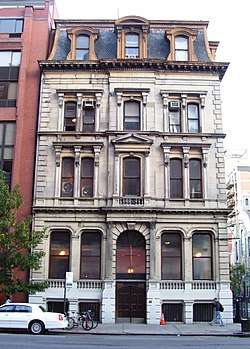Metropolitan Savings Bank Building
The Metropolitan Savings Bank Building opened on May 22, 1867 at the northeast corner of Third Avenue (Manhattan) – now Cooper Square – and East 7th Street, in New York City. The building, which was designed by architect Carl Pfeiffer in Second Empire style,[2] is four stories high, 45 feet (14 m) wide and 75 feet (23 m) deep, and was considered at the time it opened to be one of the most finely constructed edifices, "from garret to basement." Its facades were composed of white marble, with the upper floor being enclosed by a mansard roof. The building was fireproof, as no combustible materials were used during construction, either internally or externally. The entire cost of the structure was $150,000.
Metropolitan Savings Bank | |
 2010 | |
| Location | 9 E. 7th St., New York, New York |
|---|---|
| Coordinates | 40°43′44″N 73°59′26″W |
| Area | less than one acre |
| Built | 1867 |
| Architect | Pfeiffer, Carl |
| Architectural style | Second Empire |
| NRHP reference No. | 76001243[1] |
| Significant dates | |
| Added to NRHP | December 12, 1976 |
| Designated NYCL | November 19, 1969 |
The building was designated a New York City Landmark in 1969,[2] and was added to the National Register of Historic Place in 1979. It has an alternate address of 61 Cooper Square.
Interior design
The main hall was 53.5 feet (16.3 m) in length, and 36.83 feet (11.23 m) wide. Its height was 17.33 feet (5.28 m). Its acoustic properties were excellent.
Black walnut was used inside for building desks, chairs, and stairways. The office furniture evoked a simple design and reflected excellent taste The President's room, located behind the banking house proper, was less spacious, as offices were given the maximum space. Another feature of the interior was its immense safe.
Leasees
The fireproof construction of the Metropolitan Savings Bank enabled the rapid renting of any free space not used by the bank. The basement and cellar beneath it was leased for ten years to the Stuyvesant Safe Deposit Company. The floor just above the bank was leased by the United States Assessor of Internal Revenue. The third floor, unlet when the building first opened, was rented for a decade by the Eastern Star Lodge of Freemasons.[3]
Later uses
In 1937, the building was sold to the First Ukrainian Assembly of God, and it has been used since that time as a church, most recently by the First Ukrainian Evangelical Pentecostal Church.[2][4]
References
Notes
- "National Register Information System". National Register of Historic Places. National Park Service. March 13, 2009.
- New York City Landmarks Preservation Commission; Dolkart, Andrew S.; Postal, Matthew A. (2009). Postal, Matthew A. (ed.). Guide to New York City Landmarks (4th ed.). New York: John Wiley & Sons. ISBN 978-0-470-28963-1., p.65
- "The Metropolitan Savings Bank", New York Times (May 22, 1867), pg. 5.
- White, Norval & Willensky, Elliot (2000). AIA Guide to New York City (4th ed.). New York: Three Rivers Press. ISBN 978-0-8129-3107-5.

